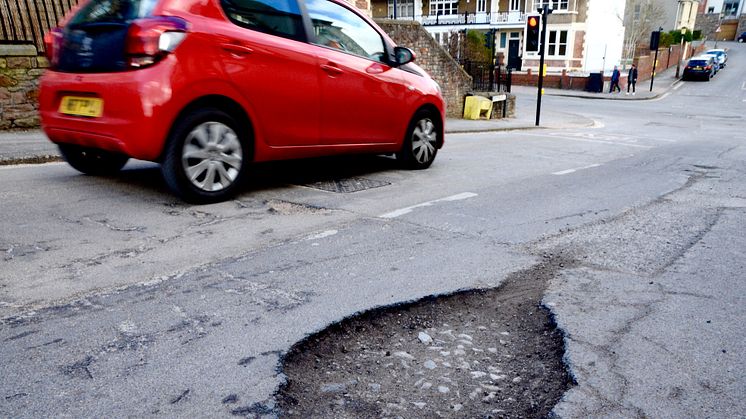
Press release -
Drivers more than twice as likely to breakdown due to hitting a pothole than 12 years ago
The UK’s perennial pothole problem shows no sign of ending any time soon, according to the latest breakdown data analysed by the RAC.
While, as is customary, the total number of pothole-related breakdowns, such as damaged shock absorbers, broken suspension springs and distorted wheels, attended by RAC patrols in the third quarter of the year dropped substantially to 1,746, the number of such call-outs seen over the last 12 months remains stubbornly high.
In the last year the RAC dealt with 14,220 breakdowns where the overwhelming likelihood was that they were caused by potholes – this represents 1.5% of all its call-outs during this period. This is the second highest percentage ever recorded since the RAC started analysing this data in 2006, with the highest being 1.6% – a figure previously only seen during 2015 and 2017.
The Pothole Index*, which is the RAC’s long-term indicator of the health of the UK’s roads, also shows that things are not getting any better as the index remains considerably higher than it was in the third quarter of 2017 when it was 2.38. In fact, with the index now standing at 2.63, motorists are now more than 2.5 times as likely to suffer a pothole breakdown than they were 12 years ago. The record high index figure was 3.5 in Q1 2010 when motorists were 3.5 times more likely to breakdown due hitting a pothole as they were in 2006.
The ongoing pothole problem highlighted by the RAC Pothole Index is clearly in line with drivers’ views as research for the RAC’s 2018 Report on Motoring has found the state of local roads to now be the issue of greatest concern.**
Data from the comprehensive study of motoring trends now in its 30th year shows a marked increase in the proportion of drivers who say the state of local roads is one of their top overall concerns, up from 33% in 2017 to 42% in 2018. More specifically, 17% cite this as their number-one concern compared to 10% in 2017.
In addition, two-thirds of the 1,808 drivers surveyed (66%) said the condition of local roads had deteriorated in the last 12 months which represents a worrying increase on 2017 when the percentage was 51%. Motorists who live in the East of England (81%), the East Midlands (82%) or Scotland (78%) had an even greater tendency to say conditions have become worse than the UK average.
Among those who say conditions are worse in 2018, the overwhelming majority (98%) blame road surfaces – this is an even higher proportion than the 92% who said this last year.
While overall concern about the state of motorways and high-speed dual carriageways has not increased significantly in 2018 relative to other issues, there is a growing number of motorists who feel the condition of these roads has also deteriorated over the last 12 months. When asked specifically for their views on the condition of the UK’s roads, 78% agreed the state of them – including motorways and major dual carriageways as well as local roads – was ‘generally poor’. Less than one in 10 (9%) disagreed with this.
RAC chief engineer David Bizley said: “There is little doubt local road conditions in many parts of the country are substandard and have been so for quite some time. Data from this quarter’s RAC Pothole Index supports this showing there has been a steady deterioration in road condition over the last 18 months with the latest quarter not showing a significant improvement. We cannot simply blame Storm Emma and the Beast from the East, even though they certainly made matters worse.
“This is consistent both with motorists’ views from this year’s RAC Report on Motoring research and the annual independent study carried out by the Asphalt Industry Alliance (AIA) which shows the backlog in terms of road repairs and maintenance continues to grow. The AIA also found that around 20% of local roads are in ‘poor structural condition’, which means they have five years of life or less remaining.
“The Government has continued to make some efforts to address the issue. In March 2018 a further £100m was made available to help local authorities repair potholes and storm damage that had resulted from the harsh winter weather.
“However, this needs to be seen in the context of the maintenance backlog of over £9.3bn reported by the AIA which is their estimate of the one-off investment required to return local roads to a state that is fit-for purpose. We need a 10-year plan with ring-fenced funding that will eliminate the backlog of preventative maintenance that will stop the plague of potholes appearing every time there is bad weather.”
Topics
Categories
Notes to Editors
* The RAC Pothole Index is a 12-month rolling measure of the share of pothole fault breakdowns compared to 2006, corrected for seasonal weather effects and improving longer term vehicle reliability Data has been collected by the RAC since 2006. Data excludes punctures.
** Research for the RAC Report on Motoring was conducted by Quadrangle using an online survey of 1,808 motorists who hold a full, current driving licence, drive at least once a month and who have a motor vehicle in their household. The research was carried out from 2-18 May 2018.
About the RAC
First formed in 1897, the RAC has been looking after the needs of its members and championing the interests of drivers for more than 120 years.
Today it has more than eight million members and is one of the UK’s most progressive motoring organisations, providing services for both private and business motorists. Whether it's roadside assistance, insurance, buying a used car, vehicle inspections and checks, legal services or up-to-the-minute traffic and travel information – the RAC offers a solution for all motoring needs. The RAC is committed to making motoring easier, safer, more affordable and more enjoyable for drivers and road users.
The RAC is the motorist’s champion and campaigns to support the interests of its members and UK drivers at a national level. This includes voicing concerns about the increasing cost of motoring, particularly the price of fuel and the high level of tax levied on it, advancing levels of road safety, and supporting the needs of all drivers, from young to old.
The RAC’s annual Report on Motoring – first published in 1989 – is one of a kind and provides a clear insight into the concerns and issues facing today’s motorists.
For the very latest news on UK fuel prices, check RAC Fuel Watch. It provides a comprehensive guide to the latest UK unleaded petrol and diesel prices – both at the wholesale level and at the pump - and tracks these prices daily to help drivers check if the price they pay to fill up is a fair one.

